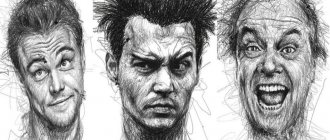What is self-awareness
Self-awareness is a person’s understanding of his own personality, his place in society and the whole picture of the world. This is the vision and analysis of personal emotions, feelings and motives of behavior.
A feature of self-awareness is that the personality is figuratively split into two:
- On the one hand, it itself is an object of knowledge;
- On the other hand, consciousness acts as a subject exploring an object.
Through self-awareness, we perceive our emotions, feelings and needs, understand the motivation of our actions and the role we play in society. We recognize ourselves as a separate person, individuality, but at the same time we are inscribed in the objective world around us.
A person can say about himself: “I am Evgeny Ivanov, I am 47 years old, I am a mechanic. I have parents, a wife and two children. My needs for shelter and food are met. I have friends with whom I spend time fishing and satisfy my need for friendly communication. But I also want to have a car and play tennis, and I'm working towards those goals now." Of course, the above description is very primitive, but it conveys the essence of the self-awareness of a person who understands his character traits and qualities that distinguish him from other people.
Self-awareness is a component of our personality and at the same time a process of self-knowledge
Self-knowledge. Essay on social studies Unified State Exam
“He who has not studied man in himself will never achieve deep knowledge of people” (N. G. Chernyshevsky)
The statement I have chosen touches on the problem of a person’s knowledge of himself, the importance and significance of a person’s comprehension of his own personality and other people. Even the ancient sages asserted: “Know yourself.” Why is this so important? A person contains not only unique, but also universal qualities, therefore, by getting to know himself, a person recognizes not only the personal and individual characteristics of his structure, but also what unites all people in common.
Russian publicist and public figure of the 19th century N. G. Chernyshevsky argued: “Those who have not studied man in himself will never achieve deep knowledge of people.” In other words, in order to make judgments about society and other people, a person first of all needs to know himself. In other words, self-knowledge according to Chernyshevsky is a fundamental stage of knowledge, study and understanding of society and other people. I completely share the opinion of Nikolai Gavrilovich Chernyshevsky and also believe that without knowing yourself, it is simply impossible to form any kind of objective judgment about other people. After all, as they say, “another person’s soul is in the dark,” and only by looking at the world and people through the prism of understanding the human essence or by trying on their roles for yourself, you can “achieve a deep knowledge of people.”
To understand the problem theoretically, let us first consider the concept of self-knowledge. Modern social scientists define self-knowledge as a special type of human cognitive activity when interest is directed towards himself. By getting to know oneself, a person seems to answer internal questions: “Who am I? What am I capable of? What am I really like? Thus, as the main objects of self-knowledge, one can single out one’s own interests, abilities, way of thinking, characteristics of the body, etc. Self-knowledge is carried out by two methods: introspection and self-research. During the first, a person observes himself, his behavior, his reactions, etc. In the second, he analyzes the information received, asks himself questions, and looks for answers to them. It is important to note that in isolation from society, self-knowledge is simply impossible, since an important component of the formation of a person’s understanding of his essence is the opinion of the people around him about him.
The final result of self-knowledge can be considered a person’s full understanding of himself, or, as psychologists call it, the formation of a self-concept, or the image of “I.” At its core, the self-concept is a system of an individual’s ideas about himself, a conscious, reflective part of the personality. These ideas about oneself are more or less conscious and are relatively stable. The subject of an individual’s self-perception and self-esteem can be his body, his way of thinking, his abilities, his social and behavioral characteristics and many other personal manifestations. Based on the self-concept, a person builds interaction with other people and with himself. Its formation begins in early childhood and is more or less formed by the age of 16. However, a person’s self-knowledge continues throughout life. In this context, I am reminded of the phrase of the 2nd century AD Roman emperor Marcus Aurelius: “Start with yourself and examine yourself first.”
The thought of N. G. Chernyshevsky is accepted by all modern psychologists. Almost any psychological training on personality development, basic communications, personnel management or manipulation begins with an introduction to personality psychology course. That is, before starting to learn to communicate with other people and manage them, a person must master the basics: understand the essence of personality, that is, study himself and his psychology. Modern psychologists are confident that this knowledge is basic for studying relationships between people.
Another illustration of this problem can be the worldview of the great Russian writer and philosopher of the late 19th - early 20th centuries, Lev Nikolaevich Tolstoy. He purposefully followed the path of self-knowledge, analyzed his actions, and described the events of his inner life. The purpose of this was to get to the bottom of the truth: to understand why he and other people act this way and not otherwise, where love and hatred, good and evil come from in a person, how his character is formed.
You can also give an example from the literature. In Jack London's novel Martin Eden, the main character in knowing himself finds the key to knowing other people. So, only having learned something about himself, having comprehended his views on the world and values, does he see the real, actual image of his beloved. He understands that she is an ordinary girl, a standard representative of her social class; that “bright and radiant image” was nothing more than an appearance that was created due to Martin’s own lack of life experience. Thus, having understood himself, he saw the real state of affairs and was able to make the right choice.
As an argument from personal experience, I can cite my own observations. My peers are just at the age when a person’s understanding of himself begins to form, a picture of his personality begins to be formed. By analyzing others, we find something similar and close in ourselves, and, conversely, by analyzing ourselves, we acquire the ability to understand other people. That is, for a person who knows and understands himself, it will not be difficult to understand his interlocutor, find a common language with him, and solve this or that problem without any special difficulties.
Thus, after analyzing the theoretical material and presenting factual arguments, we can come to the conclusion that self-knowledge for a person is the key to understanding other people and the structure of their relationships. In other words, only a person who knows himself is able to achieve “deep knowledge of people.”
| < Previous | Next > |
myessay.ru
Functions of self-awareness
Its main function is to make available to a person his own motives and the results of his actions, to provide the opportunity for self-esteem. Self-awareness ensures a person's conscious adaptation to the environment.
Other features include:
- Ensuring internal consistency (sometimes self-awareness may even not allow certain external factors into the internal world if they do not correspond to something from the person's own self);
- Interpretation of individual experience, i.e. the nature of the perception of the situation (self-awareness and self-concept explain why two people can perceive the same situation differently, i.e. the self-concept not only interprets our behavior, but also “explains” to us the meaning of the behavior of other people);
- Setting expectations, e.g. what should happen (closely related to acceptance and non-acceptance, as well as vision of the situation).
By understanding the essence and structure of self-awareness, as well as its functions, it is easy to understand and see how different and unique each person is. “I expected one thing, but got something else,” “I wanted the best, but it turned out as always,” “This is not what I wanted,” “I know I’ll look stupid again,” “Come on, he wasn’t flirting.” . I'm sure I can't please anyone" - these are all games with self-awareness and its 3 main functions.
Ways to find information
In modern times, information search has become one of the ways to understand the world around us. A wide variety of media greatly increases a person’s cognitive capabilities. Thus, cognition is carried out through:
- printed publications (newspapers, books, magazines);
- Internet;
- television;
- radio broadcasting;
Using the Internet you can very quickly and easily find almost any information, but it is not always reliable. Therefore, when choosing ways to search for information, you need to be careful and check data in different sources.
Example. In 2012, many articles were published on the Internet that foreshadowed the end of the world. Some talked about an asteroid falling to Earth, others about global warming and flooding of the land surface. But this could be easily verified by finding research by different scientists about upcoming natural disasters and comparing their results with each other.
Criteria for self-awareness
There are four criteria that help understand the meaning of self-awareness
- Distinction from the environment, that is, awareness of oneself as an autonomous individual in relation to the social and physical environment;
- Awareness of activity;
- Awareness of oneself “through another.” That is, what a person sees in others, he perceives as a reflection of his own qualities;
- In order to evaluate oneself from a moral point of view, it is necessary to have reflection, that is, awareness of one’s internal experience.
Conclusion
At the end of this article, I would like to add that the full realization of one’s “I”: aspirations, desires, as well as other factors, is the final result that one must strive to achieve. It is necessary to realize that individuality is not bad - it is the norm. We don't have to be all random. With such success, including desire, we will simply begin the process of complete degradation of all humanity.
Only through individualization are we able to realize ourselves as individuals , trying on different images. Look for your unique style and path. Self-knowledge as a component of self-awareness helps us avoid cliches, open our “shell”, accept and love ourselves as we are. Remember how we previously described the influence of self-esteem on a person’s willingness to develop. Help yourself become a level higher in your aspirations, become a little better!
Topics: Goals and desires, Personal growth, Self-esteem, Self-realization
Forms and levels of human self-awareness
Self-awareness comes in four forms, let's look at each of them.
Self-knowledge
This means identification with other people and the world around us, recognition of personal qualities, the physical body and one's own potential.
Self-awareness comes through it:
- Self-observation of the results of one’s actions, the results of communication with the environment and analysis of the compliance of these results with accepted standards.
- Understanding other people's assessments of one's own personality and actions, as well as their attitudes.
- Analysis of your own feelings, emotions and needs and their transformation.
The result of self-knowledge is the formation of a system of ideas about oneself.
Self-control
Having analyzed his character and behavior, a person gets the opportunity to make changes in himself. Any action or mental state can be changed if, in a person’s opinion, it contradicts his attitudes, does not bring the desired results, or is in conflict with the outside world.
Self-esteem
Self-esteem expresses the degree to which a person perceives his own qualities, characteristics and attributes. The perception itself shows the level of pride and self-esteem.
Adequate self-esteem is characteristic of a self-confident person who is able to make decisions and act purposefully. When low, we see a person dependent on the opinions of others, with a pronounced sense of guilt and a lot of complexes. Overestimating your personal qualities reveals self-confidence, arrogance and aversion to criticism.
To achieve life goals, it is necessary to develop self-esteem to a normal level; in psychology there are many exercises to increase the degree of self-esteem.
Self-acceptance
This form of self-awareness includes:
- Accepting yourself as a unique individual, without unfounded criticism or self-deprecation.
- Self-esteem.
Self-esteem comes from achieving goals and realizing aspirations. A person breaks records in sports, quits smoking, finishes writing a novel - his self-esteem increases, and this is good for self-esteem.
In addition to forms, psychology considers 4 levels of self-perception:
- Sensual. This is the lowest stage at which an understanding of one’s own mental characteristics, experience, and physiological processes occurs. This is the stage of self-identification.
- Image personality. This gives recognition of oneself as an active subject. Self-realization occurs, the identity of “I” is preserved.
- Analytical (or reflective). A person analyzes and explains his thoughts and actions, observes the manifestation of emotions in critical states, analyzes past failures and misfortunes, and draws conclusions.
- Active. Based on the results and experience of the first three stages, self-regulation, motivation, correction of behavioral structures and self-control occur. This is a stage of personal change based on self-awareness.
Passing through all four levels of self-awareness indicates the maturity of the individual; getting stuck on one of them requires further development.
Self-awareness is one of the elements of a conscious personality
Rational cognition
Rational knowledge is knowledge based on logical thinking. It differs from the sensory in important characteristics:
- Availability of evidence. If the result of sensory cognition are sensations obtained from one’s own experience, then the result of rational cognition are facts that can be proven using scientific methods.
- The systematic nature of the knowledge gained . Knowledge is not isolated from each other, it is interconnected into a system of concepts and theories, forming separate sciences.
Example. History is a science based on rational knowledge. All knowledge obtained with its help is systematized and complements each other.
- The presence of a conceptual apparatus . Thanks to rational knowledge, concepts and definitions are created that can be used in the future.
Methods of rational cognition are:
- logical method (the use of logical thinking in knowing something);
- synthesis (connection of individual parts, data into a single whole);
- observation;
- measurement;
- comparison (determining differences, similarities);
All existing sciences and teachings were created on the basis of rational knowledge.
Levels of Awareness
Below we will discuss the three levels of self-awareness and how they affect a person's life. Even if you think you're living consciously, you can still find a lot of interesting things here. All people have moments when they do things on autopilot or make unconscious decisions. I deal with this every day and notice it in myself very often, although I try to control all my decisions.
I don't see a problem with the fact that we do many things on autopilot. The main problem I see is that at some point we get so used to it that we stop noticing that we do many things without thinking.
Level 1 – What are you doing?
I cannot boast that I am old and wise, but even in the 26 years I have lived, I have experienced many different emotions. I experienced betrayal, several moves, moving to another city, difficulties in personal relationships and conflicts with people close to me.
Now let's try together to remember everything that you have experienced over the past 30 days.
- How often have you had difficulties in relationships with people close to you?
- How often and how lonely have you felt?
- How often have you felt lost and unproductive?
- How often have you felt like you're not getting enough sleep or not eating enough?
- How often have you felt bad and lacked the strength to act?
- How often have you felt uncertain about your future?
- How often have you worried about your job or financial situation?
- How often have you accidentally hurt yourself? (cuts, bruises).
Chances are that if you think carefully about the last 30 days, you can find many such events. All this is very scary if you are just now realizing that there have been many similar events in your life.
Often we have to do things that we don't like, and sometimes even things that make us very angry. Sometimes we get stuck on the phone purely automatically, unconsciously, because we are used to it. If we start thinking about it, we will realize that there is nothing new or important there.
We often do things to dull the pain of our real problems. We even eat, get drunk and have sex, sometimes not because of our own desire to do this here and now, but to dull the pain of our current problems. If you think about it, people deliberately enjoy entertaining literature, games and music in order to at least temporarily escape from reality.
There's nothing wrong with trying to have fun and forget about your problems for a while. All this is necessary so that we can maintain our sanity.
We need to make sure that we are now consciously choosing entertainment and procrastination, rather than that procrastination is choosing us. We must be sure that we have already made our choice and are doing exactly what we really want. We need to know this because our distractions can consume us very quickly, so we need to stop and enjoy small portions of entertainment.
If you come home after work and turn on an episode of your favorite TV series, that's completely normal. It is completely abnormal if you took a day off from work to make your plans and then watched the series around the clock.
We all think we are in control of our time and know exactly how we spend it. Unfortunately, we are usually wrong. In fact, most people work no more than 3 hours a day, and the rest of the time the person just watches something else. We constantly feel like we spend much more time with our loved ones than we actually do. We always feel like we are underestimated, but we are not. It’s just that we are more accurately assessed from the outside, and we think that we are more productive and smart than we really are. People have very inaccurate estimates of themselves, their abilities and their time.
Don't judge yourself for all this, just accept this fact. This will help you better evaluate yourself and your abilities, and this will be the first step towards self-awareness.
Second level. What do you feel?
If you try to live mindfully, you often begin to notice that the more you are distracted from reality, the more you return to the emotions that you were trying to avoid. If we are angry, we should fight the reasons for it, and not try to distract ourselves from this emotion.
If a person is at the second level of self-awareness, he thinks a little differently. They have a very clear idea of the emotions they experience at one time or another. Some emotions can help us, while others can only hinder us.
Most people live their lives somewhere around the first level of consciousness. All they have to do is work, do what they are told, and indulge in watching soap operas in the evenings with a can of cold beer. If you disrupt their routine, they will immediately begin to realize that their life is not good enough for them. They begin to realize that they are not comfortable in their own lives. Although usually, if everything has stabilized for a person, he can live like this all his life and feel quite comfortable.
The second level of self-awareness is closely related to emotions and is therefore very uncomfortable for a person. It’s extremely unpleasant to realize that your life is so far from perfect that in some places it just annoys you. It is very difficult to accept the fact that sometimes emotions control us so cleverly that we do not notice it.
Learning to properly understand your emotions instead of suppressing them is quite difficult. But I don't advise people to focus too much on understanding their emotions. It is better to do this gradually, but constantly. You don't need to rush because your emotions will follow you throughout your life. You will definitely have time to explore your emotions.
Levels of self-awareness allow you to highlight your goals and plans for the future
Third level. What are you missing out on and not noticing?
The more aware you are of all your actions and emotions, the more you notice that you are far from perfect, and in some places even too bad. Most of our thoughts are simply a reflection of our emotions that we are experiencing directly at the moment.
A person at level 3 understands some important things, which allows him to better control his anger and all other emotions:
- Our memories are often faulty, especially when the memories are associated with certain emotions or feelings at a certain time. A person is not able to predict his feelings, thoughts and emotions in the future.
- A person tends to overestimate himself. As a rule, if a person has just started doing something, he greatly exaggerates the significance of his achievements.
- Controversial questions often reinforce a person's beliefs rather than allowing them to challenge them.
- Our attention is always more focused on those things, facts and events that we expect to encounter in a given place and at a given time.
- Most people will lie if it helps them improve their performance.
- People don't know how to evaluate statistics because they always rely on personal experience and results.
This list can go on for a very long time, but it all comes down to simple definitions that should always be kept in mind:
People can make mistakes
People can do stupid things
People seek personal gain
People can speak without wanting to offend or offend
There is nothing wrong with this, because all this is natural for humans. Most of the level three “problems” described are related to a person’s self-acceptance and perception of emotions.
Features of personality self-knowledge: main functions
This whole multifaceted process is very dynamic - it is constantly in a state of active development. We are constantly learning something new that helps us in the future. This serves as additional tools in self-knowledge of our personality. Ultimately, self-knowledge as a component of self-awareness is just an end product of consumption on which everyone is dependent.
When characterizing this nonsense, one cannot fail to mention its most important functions, which are expressed in the self-defense of a person’s inner peace. This is nothing more than resistance to possible insults, negative factors that can cause great damage to a person’s psychological balance, as well as inner peace. In particular, you should remember about the formation of your individual and unique personality, the personal “I” of which did not exist before.
Under personalized consciousness, i.e. “I” understand distinctive character traits, charisma, and pronounced behavioral patterns.
Not the last factor also affects a person’s self-esteem. Self-knowledge as a component of self-awareness is distinguished by the possibility of self-identification. the presence of children's hidden fears and complexes that will interfere with the development process in any direction throughout life.
The structure of the self-concept
At the same time, if we look at the products of self-consciousness - self-images - we can distinguish
- The real me (who I am now);
- Ideal self (what I could become according to my capabilities);
- Fantastic Self (what I could become if it were possible).
The contradiction between self-relevance and the ideal “I” can serve as both a stimulus for self-development and a cause of personality disharmony. It is worth noting that self-awareness is a dynamic structure. He is susceptible to changes and transformations in self-perception.
Some theories include a broader classification of self-perception. It is distinguished by:
- Self-reality;
- The ideal of self;
- Self-potential;
- Independence;
- Independent activity (professional, non-professional).
In other works, for example, in S. Samuel, you can find this concept:
- Independent body;
- Self-presentation (real, factual);
- Self-dynamics;
- I am fiction;
- Self-presented;
- Imaginary;
- Self-perception;
- Self-ideal;
- Independent future (possible).
I am corporeal
Each person has his own sense of his own body, which may differ from the image in the mirror. This refers to the signals sent to the brain about the position of body parts, their shape and length. Within our own body we can make a further distinction:
- Realistic perception in terms of subjective functionality;
- Internal factors caused by personal experiences or difficult situations;
- Social factors, i.e. environmental reactions and the individual's interpretation of these reactions;
- ideal body image as the result of the sum of all factors, comparison and perception of the individual’s body.
Real Me
The totality of a person's current self-image (how he or she perceives himself or herself). However, this idea does not necessarily correspond to objective reality. The real self provides flexibility in responding to changing environmental conditions. It allows a person to choose goals, action strategies, ambitions and other things.
Self-dynamic
Reflects a person’s ideas about himself, but in projection, i.e. what a person wants to become (goal). Depends on a person’s social status, his abilities and successes. Autodynamics is subject to change, it is influenced by a person’s successes and failures, identification with significant and ideal personalities (in his mind), ideas about desired roles and status.
I'm fantastic
Essentially, these are a person’s dreams, his ideas of what he would be like if everything were possible. As a rule, this component exists only until adolescence, and with age it begins to actively disappear.
I'm perfect
A person’s ideas about what he should become, based on learned social norms and values. Depends on the moral development of a person, his moral maturity and socialization. It is formed in the process of a person’s identification with people (heroes) whom he admires.
If the ideal of self does not move into the dynamic and then into the present, it is likely to completely disintegrate. This leads to disappointment and frustration.
I am possible (future)
A person's idea of what he can become. Most often differs from the ideal “I”. It is formed under the influence of a person’s actual position, his real status, opportunities and roles.
Idealized self
A person’s ideas about how he would like to be now, how he would like to see himself. This is an element that arises depending on the situation.
Self-represented
An image created and displayed by a person intentionally in order to hide undesirable (negative in his opinion) features and characteristics of self-perception. Self-perception plays a protective and adaptive role.
Most often the self-perception is close to the ideal self, but if these elements are not in harmony, then problems arise in the relationship and later the person becomes disillusioned and disappoints himself. A sign of such inadequacy and incipient disappointment is embarrassment.
I'm fake
Represents a distortion of the true self, i.e. self-deception of the individual. In the frequent reproduction of false but desirable personality traits:
- fear of negative self-perception;
- expects a negative attitude from others;
- unable to act in ways that enhance self-esteem.
The false “I” triggers many personality defense mechanisms, which ultimately become pathological. The entire perception of oneself is distorted, and subsequently the cognition and perception of interpersonal relationships is distorted.
Unified State Exam. Cognition Topic 7. Self-knowledge |
The most difficult thing is to know yourself. That's what the ancients said. Yes, indeed, to understand a person what he is like and from what position to approach self-esteem is very difficult, but necessary. A person must strive for self-improvement, which means he must learn to know himself.
Self-knowledge is a cognitive activity aimed at knowing oneself, one’s mental and physical characteristics, and understanding oneself as an individual.
This process lasts a lifetime. It is human nature to strive to understand: who he is, what he is like, what his purpose on earth is, how others evaluate and perceive him.
Self-concept (or self-image) is a person’s idea of himself.
Self-images:
- I am open (I know about myself, everyone knows about me)
- I am private (I know others don’t know this about me)
- I am blind (others know, but I don’t know)
- I am the unknown (no one knows this about me, not even me)
Self-esteem is a person’s assessment of his abilities and capabilities. May be adequate, overestimated or underestimated .
Stages of self-knowledge
- Primary stage. At this stage, self-recognition, a trusting perception of oneself from the positions of others, and a sensory perception of the world occur.
- Crisis of the primary stage of self-knowledge , when a person understands the contradictory opinions of others about himself, his own opinion about himself begins to form.
- Secondary stage. This is a period of active self-knowledge, a revision of one’s previous self-perception, and the formation of self-esteem.
Methods of self-knowledge
- Self-observation . His goal is to monitor his actions, thoughts, and behavior.
- Self-comparison. A person compares himself with the people around him or with the heroes of works, sets certain guidelines: in what ways he wants to be like them, in what ways he doesn’t. A person develops likes and dislikes for people. He seeks to understand the reasons for this.
- Method of unity of opposites. This is the desire to understand yourself and accept yourself as you are.
- Self-analysis - analysis of one’s actions, behavior, words. Self-assessment is evaluating one’s actions. The UN is not always objective and self-critical.
Means of self-knowledge
- Self-report and self-confession (diary, blog, oral reflections)
- Comparing oneself with the characters of books, theatrical productions, films, the desire to evaluate one’s capabilities.
- Study of psychological literature
- Consultations with psychologists who help you understand yourself, the cause of conflicts, for example, outline solutions.
- Participation in various types of testing in order to identify the level of development of one’s abilities and capabilities.
- Participation in socio-psychological trainings , which significantly speeds up the process of self-knowledge.
Thus , the desire to understand and know oneself is characteristic of every person. This helps him to realize himself, enjoy life, and be a happy person.
Material prepared by: Melnikova Vera Aleksandrovna
obschestvoznanie-ege.ru
Functions of self-concept
The self-concept is very important in life and personal development: it helps to achieve internal consistency, determines the interpretation of experience and acts as a source of expectations.
The “I-concept” has several important functions
Ensuring internal personality consistency
The most important function of the self-concept is to ensure the internal consistency of the individual and the stability of his behavior. If an individual’s new experience corresponds to his self-concept, then he easily adapts and enters into this self-concept. Then, when the new experience cannot be accommodated into the self-concept and a conflict arises with the existing self-concept, psychological defense mechanisms are activated that help the person find the correct interpretation of the traumatic experience or deny it. This helps keep the self-concept in balance even when it is threatened by real facts. This desire to protect self-perception, to protect it from harmful influences, is one of the most important motives for any adequate behavior.
The term “defense mechanisms” was introduced by Freud in 1926. Currently, psychological defense is understood as helping a person to protect himself from influences that threaten to put him at risk and lead to the disintegration of his personality. The main characteristic of different types of defense mechanisms is that
- they are unconscious, i.e. a person is not aware of the reasons, motives, goals and the fact of his protective behavior in relation to any phenomenon or object
- they always distort, falsify or replace reality. For this reason, they are most often perceived as maladaptive.
The protective mechanism of repression is the earliest known. It occupies a special place in psychoanalytic theory. Denial is often called “motivated forgetting” because it is the process of eliminating thoughts and feelings that cause anxiety. But getting rid of anxiety through repression does not come without consequences. 3) Freud noted that thoughts and impulses that have been suppressed do not cease to be active in the unconscious, but must constantly expend psychic energy in order to prevent them from entering consciousness. This repressed material tends to manifest itself openly, sometimes in dreams, jokes, slips of the tongue, and other manifestations of what Freud called “the psychopathology of everyday life.”
Another defense mechanism is denial, which is an unconscious refusal to acknowledge the existence of certain events, experiences, and feelings that cause a person pain when acknowledging them. For example, a person who is terminally ill but continues to work at his current job and avoids talking about his illness makes long-term plans. A person whose main mechanism is denial always insists that “everything is fine and everything is going according to plan.”
Projection is a process in which the internal is falsely perceived as coming from without, i.e. through projection, a person attributes his unacceptable thoughts, attitudes, and desires to others. An obvious way to protect yourself from the anxiety that comes with failure or guilt is to place the blame on someone else. The person is not aware of his own hostile impulses, but sees them in others, and then perceives these others as hating and persecuting him.
The reactive mechanism involves the transformation of negative affect into positive or vice versa. This mechanism involves preventing the expression of unacceptable desires and feelings by developing attitudes and behavior that resist them. The reaction formation mechanism is gradual. At the first moment, the rejected impulse is eliminated, after which a directly opposite impulse arises at the level of consciousness. A little girl “loves” her little brother so much that she stays up all night with him, afraid he will suddenly stop breathing.
Rationalization refers to false reasoning through which irrational behavior appears to be entirely reasonable and justifiable in the eyes of others. There are many forms of rationalization. A person who says that the job from which he was fired has not attracted him for a long time is rationalizing; a boyfriend who decides that the girl who rejected him is not very attractive. The "sweet lemon" phenomenon sometimes plays a similar role: a person who has had to endure unpleasant conditions begins to find them quite desirable through rationalization.
Sublimation is a process of healthy coping with psychological difficulties by converting sexual or aggressive energy into artistic or intellectual creativity.
Individual's interpretation of experience
The second function of the self-concept is that it gives character to the individual's interpretation of his own experience. The self-concept acts as a kind of internal filter that determines how a person perceives any situation. When a situation passes through this filter, it is rationalized, understood and given a meaning that corresponds to the individual's perception of himself.
Determining the individual's expectations
The third function of the self-concept is that it is the basis for a person's expectations. In other words, it gives a glimpse of what's coming next. People who are confident in their worth expect others to treat them kindly, while people who doubt their worth tend to believe that no one will like them and avoid all social contact.
The concept of archetypes in Jung's theory
The concept of archetypes, which was developed within the framework of Jung's theory, is also of genuine interest. These archetypes are a set of images that prove in practice that self-knowledge as a component of self-awareness mainly operates at the subconscious level, rather than during analysis as a whole. We try on the model of a specific archetype, which plays a leading role in our subconscious. The leading images (archetypes) in his mind were:
- The shadow is a totem of the dark essence of humanity: all its suppressed emotions (fear, aggression), which essentially represent the animal essence. She does not have any moral and ethical standards inherent in the individual. This imprint carries all the dreams that are condemned by society, but no less desirable. But despite this, the “shadow” also carries positive features - it is a natural source of people’s vitality, their spontaneity and creativity. Its main function is to direct energy in the required direction , eliminating all kinds of fears of failure;
- Persona is our façade, roughly speaking, “the face for the cover.” Jung's theory states: this archetype is recognized to be preserved under the guise of correctness and goodness by our inner demons, in order to produce a positive effect on society. The negative qualities of a “person” are our aspirations and endeavors. "How?" - you ask. Yes, it’s very simple, because the main goal of his (person’s) life is to please everyone, presenting himself only in the best light. In the future, this threatens the complete loss of all individual and distinctive features, everything that makes us ourselves;
- The Self is the leading archetype, what each of us should strive for. It is he who gives the irrefutable axiom that self-knowledge as a component of self-awareness requires complete harmony in all relationships: from emotions to internal beliefs. In his understanding, all human existence is aimed directly at this image - the “face of the saint,” which in the eyes of the whole world was and is the standard of perfection. This standard was not darkened by the filth of sinfulness and depravity, which is why we look up to this “inner purity”;
How self-awareness is formed
The first stage is the formation of a person’s personality. They first hear it from their parents and begin to identify with it. The name lets the child know that he is an individual. Then the surname and patronymic are added to the name, which become more and more specific.
At primary school age, the name may change, other interpretations appear, and nicknames accompany it. During adolescence, many people give themselves other names to associate their identity with them. There are cases when people change their passport details during this period.
Another need for self-awareness is body image, which is formed first under the influence of the attitudes of the immediate environment (parents, grandparents), and then under the influence of family traditions and cultural orientations.
The need for recognition also arises in early childhood. The child learns what is right and wrong, allowed and not allowed. Reward for good deeds and good behavior leads to the desire to perform approved actions.
If demands for recognition are not met by adults, the child develops negative character traits such as lies, aggression, lack of self-confidence and complexes.
During adolescence, adolescents develop a gender identity. Obviously, being a boy or a girl is determined already at the age of three; a little later, stereotypes of male or female behavior appear.
In the process of introspection and self-understanding, the individual forms an idea of social space, i.e. about the environment in which growth and development occurs:
- Lifestyle and lifestyle;
- Cultural and ethical values;
- Moral standards;
- attitude towards religion, etc.
During adolescence, a person strives to master the widest possible social space (from a group of friends in the backyard to the political sphere). During this same period, reflections on the inner world deepen in order to realize one’s own needs and place in society.
The main signs of self-awareness are: the presence of a holistic view of oneself, self-respect, self-acceptance, awareness of love and the discovery of one’s inner world.
Self-awareness goes through several stages of formation
Awareness of your name
A name is an important part of identity. The child will understand his name as one of the first elements of self-awareness. He/she constantly hears this name from his/her parents and gradually begins to identify with it. This further helps him/her define himself/herself as a person. Later the child learns that he has a name and becomes more specific.
Most children learn to recognize themselves around the age of three. Before this, they call themselves by name, as others call them.
Then the child comes up with nicknames for himself and learns to play the roles of various characters from children's games. As they grow older, they may come up with a new name and try to make it their own to highlight their individuality. For some teenagers, this is so important that they change their name to their real name when they receive documents.
Awareness of your body
Basic knowledge about one's own body and its boundaries is formed in a child at about the age of one year. Later he learns to recognize himself in the mirror, learns that he is growing and that his body is constantly changing. He learns the pain of bruises and other injuries and that his actions can cause pain to others.
Need for recognition
Because children are self-centered, they expect all attention to be focused on them. Gradually they learn which actions are good and which are bad. Every time he does a good deed, he expects adults to appreciate and approve of him. If adults do not respond appropriately to his behavior, he may develop negative character traits - aggressiveness, meanness and lack of self-confidence.
Gender identification
Although children become aware of their gender at an early age and the first feelings between boys and girls appear in elementary school, true gender identity is formed only in adolescence. Stereotypes of male and female behavior develop, and boys begin to consider themselves men, and girls - women.
5. Idea of social space
As children grow up, they develop and change their perception of social space. This also applies to the conditions in which children live:
- everyday life and ways of being;
- society-specific values;
- education, moral standards;
- religion, etc.
In adolescence, a person experiences a desire to expand his social space, but does not realize what he needs, and therefore tends to sharply change priorities and make impulsive decisions.
The problem of self-knowledge
Self-knowledge is included in self-awareness as one of the main processes that ensures its content and dynamics. It is determined by the dynamic side of self-awareness and underlies its functional manifestations. It is from this position that one can broadly consider self-knowledge and analyze its possibilities.
As the ancient Greek philosopher Socrates said: “Know yourself.” That is, this is a primary and very difficult task: not knowledge of the world around us, but knowledge of oneself. Many philosophers and scientists thought about this, tried to solve this problem, to answer the question “what is a person”, or more precisely, “what is I”. But this problem has not yet been solved, like any other philosophical problem.
The problem of self-knowledge is insoluble, but extremely important in itself. The act of self-knowledge and the act of self-esteem is called reflection , when a person doing something becomes aware of himself. When he thinks about himself while doing something, he understands that I am doing it.
The existing pattern in the relationship between self-awareness and self-knowledge is sometimes viewed from opposite points of view:
- in the first version, self-knowledge is seen as the conditions of self-consciousness;
- in the second - only its result.
Despite the obvious importance of self-knowledge in methodological, theoretical and applied terms, this problem still remains insufficiently studied. The very right to the existence of self-knowledge as a scientific concept and scientific problem is being questioned.
As more precise equivalents, modern scientific literature often uses concepts such as “knowledge of one’s mental states,” “self-image,” “self-esteem,” “self-image,” etc.
Mistakes in the development of self-awareness
If the crisis is not resolved properly, the personality will be inadequate. We can distinguish the following options for inadequate development of self-awareness, which affect the individual and his relationships with the world:
- Avoidance of close interpersonal relationships.
- Fear of change and growing up, inadequate understanding of time, blurring of its boundaries.
- Wasting your own potential, productivity and creativity. Inability to mobilize internal resources and focus on one type of activity.
- Refusal of self-determination and self-knowledge, choice of negative role models.
Separately, I would like to consider the option of developing unfavorable self-acceptance, which is characterized by a person’s lack of self-confidence, fear of rejection, and low self-esteem. This type of self-acceptance is dangerous in the following ways:
- low self-esteem, which manifests itself in social degradation, failure, aggressiveness, crime and antisociality;
- adaptive reaction in difficult situations, with the risk of being drawn into antisocial groups and succumbing to external influence;
- inadequate perception, which manifests itself both in a person’s analysis of his actions or appearance, and in the analysis of external situations.
Other disturbances in the development of self-awareness include:
- undeveloped self-awareness, i.e. dependence on other people;
- distorted self-image;
- Egocentrism (distorted idea of one’s role in the world);
- Pathologies (mental illnesses and illnesses).
The rich inner world of man
The inner world of a person is his desires, goals, beliefs, worldview, ideas about himself and other people, values. You can notice your appearance immediately and appreciate its attractiveness, but with the inner world things are more complicated. At first glance it is invisible, but over time it manifests itself in a person’s communication and actions.
It often happens that an outwardly unattractive person still evokes sympathy due to his inner qualities. Conversely, a beautiful person quickly causes disappointment if he behaves stupidly, impudently, and selfishly. So the inner world and appearance, actions - form a single whole, making up a general idea of \u200b\u200ba person.
Developing Self Awareness
Self-awareness appears in a child in early infancy and is fully formed in adolescence. However, this does not mean that you do not need to engage in self-perception throughout your life.
Changes occur in the objective world and in subjective qualities. These changes require observation and self-knowledge.
The first step is to analyze the current external and internal situation and rediscover yourself and your attitude to change. For example, with age, the body begins to age, and our attitude towards it, formed in earlier periods, will also change. On the one hand, it is necessary to take greater care of our physical health, and on the other hand, we must be able to accept the changes associated with aging without undue stress and with dignity.
It is also important to bring self-esteem to an appropriate (normal) state. Throughout life, the level of self-love and self-esteem may change under the influence of external reasons or the attitude of loved ones. You cannot allow circumstances to sow doubts about your self-confidence.
Finally, it is important to adjust needs and actions in a timely manner to adapt to life changes. It is unconstructive to focus on self-knowledge, it is unconstructive to take the same actions that do not lead to success. Therefore, the process of self-knowledge is constant and ends only after physical death.
Factors of self-esteem and behavior
Self-esteem refers to the emotional attitude towards a personal image. This indicator is always subjective. At the same time, self-esteem can be realistic in individuals who are oriented towards success in their lives, and unrealistic - underestimated/overestimated in individuals who are trying to avoid failures.
The following factors influence self-esteem:
- a person’s attitude towards personal failures, advancements, successes;
- assessment of surrounding individuals, self-comparison with them;
- comparison with the ideal “I”.
Actions are actions that are considered within the framework of the unity of consequences and motives, means and goals, deeds and intentions. To designate the behavior of an individual in society, the designation “social behavior” is used.
In turn, behavior is a complex of actions of a person that are performed by him during changing conditions over a long period of time. When an activity contains only one action, then behavior consists of specific actions.
Concept of self-image
The image of “I” is a relatively stable, most often fixed, conscious idea of an individual about himself in verbal form. In this case, self-knowledge is closely associated with reflection, reflecting the process of a person’s thoughts regarding everything that happens in her mind. The described phenomenon contains the individual’s personal view of himself, as well as individual groups and individuals that are especially important to him.
Types of social behavior
Social behavior is understood as a person’s behavior in society, which should influence him and those around him in general.
Social behavior is divided into types:
- helping;
- prosocial/asocial – the main motive for actions is goodness;
- deviant/deviant – illegal;
- group – common actions of a group of individuals;
- mass – the masses are active, but are not organized and do not have a specific task.
There are important types of social behavior that are associated with:
- uncertainty, self-confidence;
- the desire to achieve power, to be successful;
- a manifestation of humanism, enmity and friendship, evil and good.
Customs and mores: interpretation of concepts
“Morals” are understood as standard reactions to specific events repeated by a large number of people. Morals are transformed as the consciousness of individuals changes. They are based on habits.
Customs are forms of behavior of people in certain situations. Society unswervingly follows the customs of their country, without even thinking about their origin or why they exist.
The expression of social responsibility is manifested in the tendency of people to behave in full accordance with the interests of the surrounding individuals.











